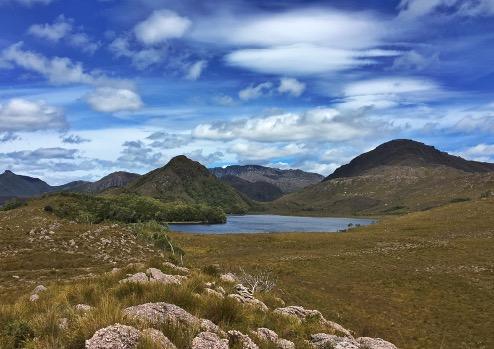“This is the first study of this kind in Australia since pioneering studies in the 1980s,” said author Dr Agathe Lisé-Provonost, a McKenzie Fellow from the School of Earth Sciences at the University of Melbourne.
“Just two lakes in north-east Australia previously provided such “full-vector” record, where both the past directions and the past intensity of the Earth magnetic field are obtained from the same cores.”
Published in the journal Quaternary Geochronology, Chronostratigraphy of a 270-ka sediment record from Lake Selina, Tasmania: Combining radiometric, geomagnetic and climatic dating, details how drilling into the 5.5 metre long Lake Selina core established that 41,000 years ago, people in Tasmania must have seen spectacular auroras when the Earth’s magnetic field flipped, and for a few thousand years, north was south and south was north.
“During the geomagnetic ‘excursion’, the strength of the Earth’s magnetic field almost vanished,” said DrLisé-Provonost.
“This would lead to a big increase in cosmic and solar particles bombarding our planet because the magnetic field normally acts like a shield.
“We don’t know when the next geomagnetic excursion will happen, but if one was to occur today, satellites would be rendered useless, smartphone navigation apps would fail, and there would be major disruptions of power distribution systems.”
Research leading to that discovery got underway in 2014 when the author travelled to a small sub-alpine lake in western Tasmania with a team led by Associate Professor Michael-Shawn Fletcher, where a makeshift floating platform rigged to two inflatable rafts was used to drill down into the sediment.
With the core containing a climate, vegetation, and paleomagnetic record of the area, the team looked to first accurately date its layers finding evidence of the ecosystem changes that occurred as Tasmanian Aboriginals arrived 43,000 years ago and managed the land over thousands of years. Abrupt changes that occurred since the arrival of Europeans 200 years ago are also evidenced.
“Magnetic particles are eroded from rocks, making their way to a lake by wind or water, and settle down on the lake bottom,” said Dr Lisé-Provonost.
“The magnetic particles act like tiny compass needles, aligning with the Earth’s magnetic field. As these particles accumulate and become buried, they become locked in place, leaving a history of the Earth’s magnetic field. The deeper we drill, the further back in time we go.”
It’s hoped the research will lead the way for more studies of the past geomagnetic field behavior from Australian lakes and other geological materials such as lava flows, cave deposits and fired archaeological artefacts, for developing new paleomagnetic dating tools and improving models of the Earth’s magnetic field to, one day, maybe predict the next geomagnetic excursion.
The research team will now go even further back in time recovering the climate history of Tasmania, with analysing sediments from the 816,000 year-old meteorite impact at Darwin Crater.
###


